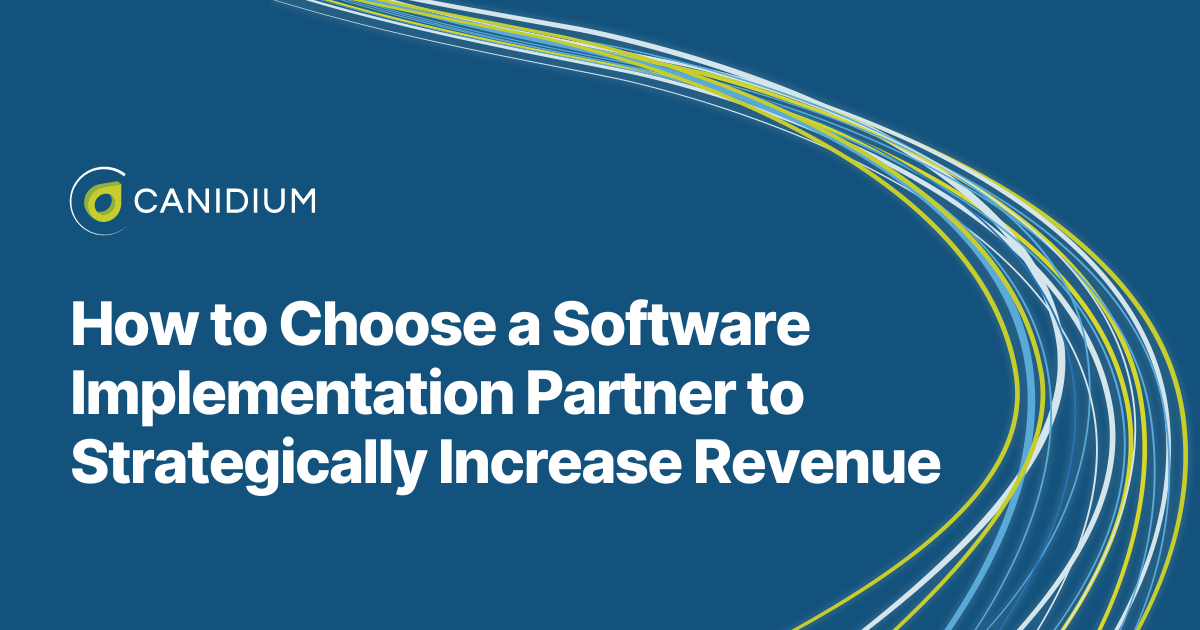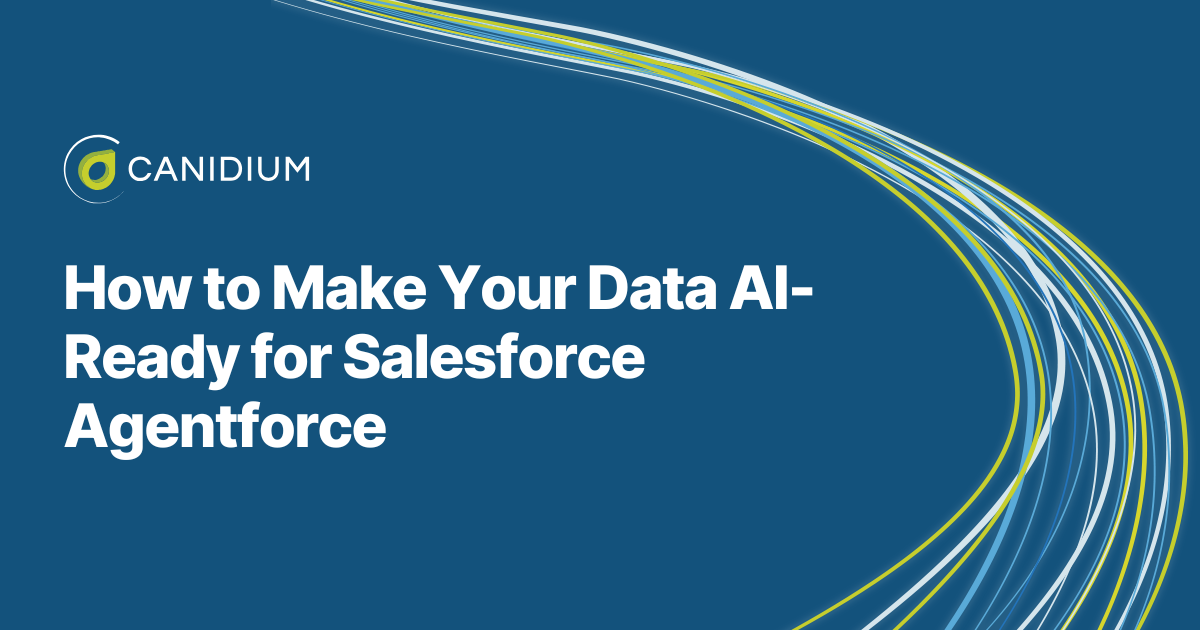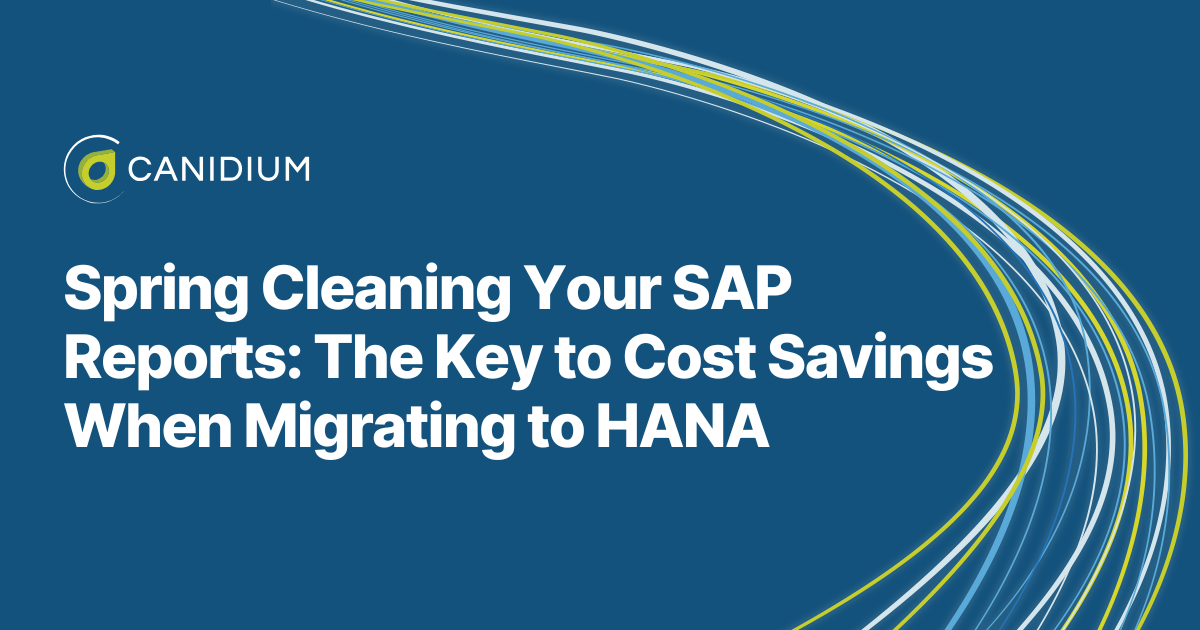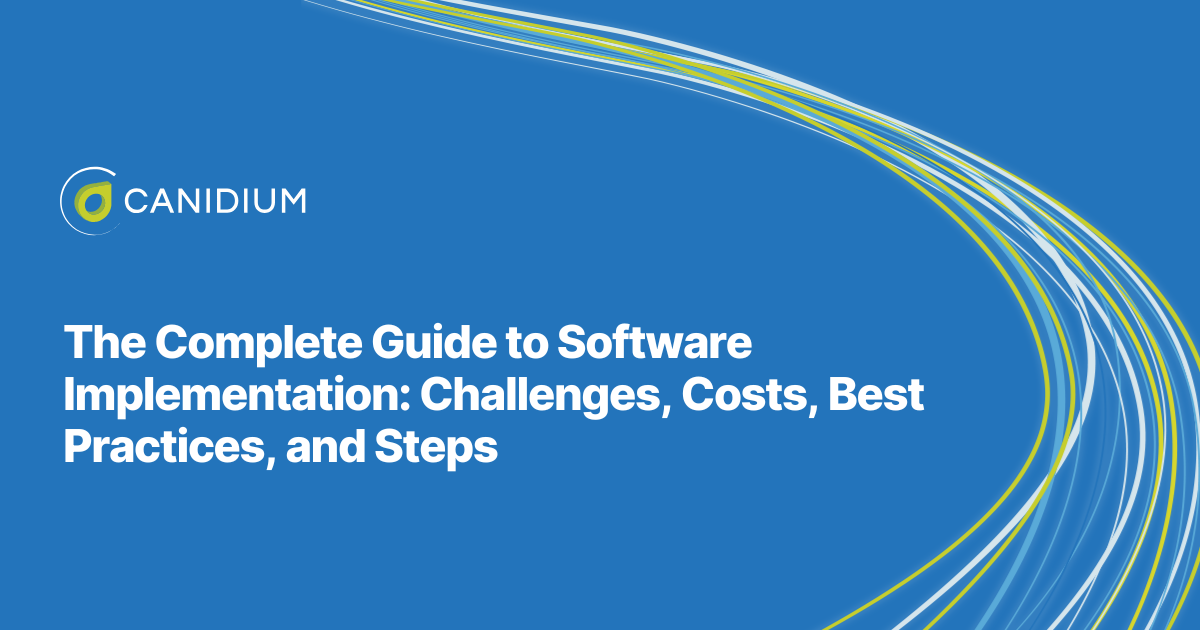You have to spend money to make money, but you also have to do a thorough cost-benefit analysis at the same time. Smart investments allow your business to grow, cut costs, and ultimately increase revenue. However, you have to be savvy with buying into new technologies.
Choosing a software implementation partner is one of the most important and lasting investment decisions you will make. Yet many leaders do not have experience with long-term implementation partnerships, making it difficult to know where to start.
Canidium is a premier software implementation service provider. We offer specialized configurations of partner solutions and ongoing long-term support for our enterprise and mid-level clients.
Based on our experience in the software implementation market, we put together this guide to choosing a partner that can strategically increase your revenue. To give you a comprehensive understanding of the topic, we will cover the following subjects:
- What Does a Software Implementation Partner Do?
- The Consequences of Choosing the Wrong Implementation Partner
- 3 Factors to Consider When Choosing an Implementation Partner
- Can You Implement Multiple Solutions Simultaneously?
- 3 Implementation Scenarios
- Partnering the With Right Implementation Experts to Increase Your Revenue
What Does a Software Implementation Partner Do?
An implementation partner does not create the software you are buying. Instead, they take out-of-the-box software, configure them to your specifications, and integrate them with your existing infrastructure.
You might think that your internal IT team could conduct this process. However, successfully implementing specialized software is more challenging than it might seem. Even the most skilled internal IT teams often do not have the specific knowledge required to successfully design and configure the new and highly sophisticated solutions businesses are increasingly buying into to meet their digital transformation goals.
Your implementation partner fills this knowledge gap, providing all the project expertise and management experience required to integrate new technologies seamlessly. By fully leveraging your software implementation partner, you can maximize the value of a new digital tool, increase your time to value, and eliminate the possible costs associated with poorly implemented solutions.
.png?width=1920&height=1080&name=Evaluate%20(5).png)
The Consequences of Choosing the Wrong Implementation Partner
The potential costs of working with the wrong implementation partner are severe. In the short term, you risk incurring additional fees for timeline delays, poorly executed requirements, and a slew of potential inefficiencies and errors. In the long term, you could significantly reduce the overall value of your new software solution. At worst, you may also disrupt existing operations with a poorly implemented solution, forcing you to switch software implementation partners.
Disruptions can lead to lost sales opportunities and frustrated customers, potentially negatively impacting your company's reputation. Ensuring minimal disruption requires a partner who can meticulously plan and execute the implementation, all while considering your business's operational needs.
The longer a project drags on, the more costs can escalate, eating into your company's budget and delaying the anticipated benefits of the new system. At the same time, the wrong partner may neglect adequate training and support. Your team may struggle to understand and utilize the new system, leading to lower adoption rates and potential errors in the quoting process. The absence of reliable post-implementation support can further exacerbate these issues, leaving your team without the necessary assistance to resolve problems as they arise.
For these reasons, it is vital that you carefully consider your implementation partner before you initiate your project.
3 Factors to Consider When Choosing an Implementation Partner
No company purposely selects a poor fit for a software implementation project. This issue often occurs when internal decision-makers lack the firsthand experience to determine proper selection criteria. Choosing your implementation partner can be challenging. They will not only manage your project but also offer ongoing support, fostering a long-term business relationship.
To help you overcome this obstacle, we analyzed four critical factors influencing partnership success to help you develop a blueprint for selecting your software implementation partner.
1. Which Software Solution You Are Implementing?
The type of software you are integrating is foundational to your choice of implementation partner. You may already know which software solution you want. However, companies often search for a new software solution by identifying problems within their workflows or business processes.
For instance, many organizations' primary goal in implementing a new solution is to increase revenue. There are multiple ways to use software to fulfill this goal. Once you select your implementation partner, their team can offer expert input on which solution best fits your needs. They are a third party to these solutions, so they will give you an objective perspective on the applicability of each solution to your specific needs.
However, you may want to gain a more specific idea of the types of software your company can use to increase revenue beforehand. With this in mind, here are several of the most impactful software types you may consider inquiring about when speaking with your prospective software implementation partner.
Incentive Compensation Management (ICM) Software
A staggering 90% of top-performing companies use strategic sales incentives and rewards to motivate their teams. The more motivated your sales team is, the more revenue they will generate. However, managing complex incentive programs at scale is traditionally error-prone and labor-intensive, degrading the returns they generate. This inefficiency is the core issue that Incentive Compensation Management Software (ICM) solves.
ICM solutions such as Xactly and SAP SuccessFactors Incentive Management are designed to manage and optimize sales incentives effectively, ensuring your team is appropriately motivated and rewarded. These solutions are critical in calculating commissions and bonuses based on real-time sales data. By automating the calculation of variable pay, ICM solutions eliminate the manual errors that often plague traditional methods, ensuring that every salesperson receives the correct compensation promptly.
One of the critical functionalities of ICM solutions is Variable Pay Management. This feature allows you to set up complex compensation structures for unit prices, discount levels, and sales volumes. Doing so can ensure that your sales team is compensated accurately based on their performance. For instance, if a salesperson offers a discount on a product, the ICM system can adjust their commission accordingly, reflecting the reduced margin.
ICM solutions also excel in Performance Tracking. By continuously monitoring sales performance, these systems provide valuable insights into how well your sales team is performing against set targets and company goals. This real-time tracking enables managers to identify high performers, address underperformance issues, and make informed decisions about future sales strategies. The ability to align sales performance with business objectives ensures everyone works towards common goals, ultimately driving higher sales and better overall performance.
Furthermore, ICM solutions facilitate designing and implementing incentive plans that motivate your sales team. These plans can be tailored to meet your business's specific needs, offering various incentives such as bonuses for achieving sales targets, additional commissions for upselling, or rewards for maintaining customer satisfaction.
The right ICM solution can keep your sales team motivated, engaged, and focused on driving sales by providing precise and achievable incentives.
Sales Performance Management (SPM) Software
Sales Performance Management (SPM) solutions go beyond incentive compensation to provide a holistic approach to managing and optimizing revenue. These solutions encompass various tools and functionalities that help you streamline sales processes, improve sales effectiveness, and align sales activities with business goals.
A crucial component of SPM solutions is performance tracking. This feature allows you to monitor sales performance, from individual sales rep achievements to overall team performance. By providing detailed analytics and reports, SPM solutions enable you to identify trends, uncover insights, and make data-driven decisions.
Incentive plans are another vital aspect of SPM solutions. While similar to ICM, SPM solutions take a broader approach by integrating incentive plans with other sales processes. For example, you can design incentive plans directly linked to sales targets, customer acquisition goals, or product-specific promotions. By aligning these incentives with your overall sales strategy, SPM solutions help ensure that your sales team is focused on activities that drive the most value for your business.
SPM solutions also offer advanced tools for guided selling. This feature helps sales reps make informed decisions by providing real-time pricing, discounting, and product configuration recommendations. By leveraging data from pricing optimization tools, SPM solutions can guide sales reps through the sales process, ensuring they offer the best possible deals while maintaining profitability. This guided approach can have a significant impact on your bottom line. For instance, SalesForce reports that its customers see a 28% increase in sales revenue.
SPM solutions also provide robust reporting and analytics capabilities. These tools enable you to gain deep insights into your sales processes, track KPIs, and measure the impact of various sales strategies.
The right SPM solution can help you identify areas for improvement, optimize sales processes, and drive continuous improvement by providing a comprehensive view of your sales performance.
Pricing Software Solutions
Implementing a pricing solution is the most direct way to grow revenue with software tools. Customers of established solutions such as Pricefx report a 30% increase in deal size and a 90% decrease in price setting cycle times.
The pricing stage of new product development is vital. Recent research found that almost half of new products fail during the pricing stage. If you plan to expand your product line or break into new markets, pricing software is an essential investment opportunity. Optimized pricing carries the potential to maximize your potential profit margins on every sale, stabilize your business during times of economic volatility, and help you secure new streams of revenue.
The core functionality of pricing solutions revolves around the ability to analyze market conditions and competitor pricing, enabling users to set optimal prices that reflect current market dynamics. This capability ensures that your pricing remains competitive without sacrificing profitability. By leveraging extensive data analytics, your solution can identify the best pricing strategies, helping you strike the perfect balance between market demands and profit margins.
One of Pricefx's standout features is its provision of real-time updates. This ensures that your sales team is always equipped with up-to-date information, reducing the lag time between market changes and your pricing adjustments. This real-time synchronization not only enhances the agility of your sales operations but also minimizes the risk of pricing errors, thereby maintaining consistency across all sales channels.
At the same time, Pricefx incorporates guided selling techniques, offering recommendations to sales representatives on discount limits and pricing strategies. This feature is particularly beneficial for complex sales processes, where the optimal pricing strategy might not be immediately apparent. This guided approach helps maintain a consistent pricing strategy across the organization, ensuring that all sales personnel adhere to predefined pricing rules and guidelines.
The tool's ability to provide data-driven insights and recommendations empowers your sales team to negotiate better deals and close sales more effectively. Pricing solutions maximize your revenue potential by optimizing pricing strategies, reducing errors, and ensuring that your sales team is always equipped with the most accurate and relevant pricing information.
Configure Price Quote (CPQ) Software
One study found that over a year, best-in-class firms are 63% more likely than all other companies to plan an increase in their CPQ deployments (52% compared to 32%).
CPQ software is vital for large-scale sales organizations. It allows them to generate quotes promptly, giving them a leg up on competitors who make their prospects wait for manually generated estimates.
We can break down CPQ software's functionality into three parts:
- Configuration: CPQ software simplifies the configuration of complex products. Whether it's an automotive emissions tester with multiple readouts or a gear manufacturing system with numerous components, CPQ handles all configurations seamlessly.
- Pricing: CPQ supports pricing structures like cost-plus, list prices, and promotions. It can suggest additional items based on the customer's history or the current items in the cart, a concept known as guided selling.
- Quoting: CPQ software can generate content-rich documents like PDFs, Excel, or Word. These documents can be sent to customers without manual input, ensuring accuracy and efficiency.
CPQ software allows users to configure complex products, set prices according to various structures, and generate detailed quotes without understanding the intricate details involved. It streamlines the entire process, making it efficient and error-free.
Imagine you are on the Domino's website, building your pizza. You start with a basic pizza and then customize it by adding various toppings. As you select each topping, the website updates your order, factoring in pepperoni, cheese, or vegetables and dynamically changing the total price as you make your selections. This approach is the work of CPQ software; it ensures that users can customize products easily, see the impact of their choices immediately, and receive accurate quotes without manual intervention.
Imagine this process applied to a more complex product, such as an industrial machine or a sophisticated software package. CPQ software allows you to configure these intricate products in a similar, user-friendly manner. For example, if each product has multiple components, such as robotic arms and various software packages, with specific tolerances based on the final gear's shape, configuring such a system manually would be error-prone and time-consuming. However, with CPQ software, the user can input the necessary details, and the system guides them through the configuration process, ensuring all components are compatible and accurately priced.
The impact of the added customer convenience that a CPQ offers is significant. The deal size of companies using CPQ software is 105% larger than average, with a 17% higher lead conversion rate and 33% greater quote productivity. CPQ software is thus a wise investment for many sales teams.
Download your guide to the benefits of pairing Pricefx with CPQ
2. Consider the Implementation Partner's Specialization
An implementation partner specializing in CPQ, pricing, ICM, and SPM solutions brings deep expertise to each area. This expertise ensures that the partner understands the nuances and complexities of each solution.
Specialized implementation partners are also adept at integrating multiple systems seamlessly. They understand how data flows between different solutions and how to configure them to work together efficiently.
Every business is unique, and a specialized implementation partner can tailor solutions to meet your specific needs. They have the experience to understand your business processes and can customize the integration to align with your goals.
Alternatively, a partner without specific expertise may lack the experience to tailor the integration to your unique processes and requirements. This knowledge gap can result in a system not optimized for your business, leading to inefficiencies and misalignment with your strategic goals. A one-size-fits-all approach often falls short of addressing your organization's challenges and opportunities.
3. Review Your Implementation Partner's Track Record
A track record of success is one of the simplest and most effective ways to tell if your prospective implementation partner is a good fit for your project. Look for evidence of successful integrations in the partner's history. A good track record should include detailed case studies or testimonials from previous clients who have benefitted from the partner's services.
Client testimonials also provide firsthand accounts of the partner's performance. Positive feedback from previous clients about the partner's ability to meet deadlines, stay within budget, and deliver high-quality solutions strongly indicates their reliability.
An excellent track record also reflects the partner's problem-solving capabilities. Unexpected challenges and issues can arise during implementation. A partner with a solid track record has a history of identifying and resolving these problems effectively.
Can You Implement Multiple Solutions Simultaneously?
Implementing multiple solutions simultaneously can significantly enhance your business's efficiency and performance. However, the success of such a complex integration depends on choosing the right implementation partner.
Simultaneous implementation of these solutions requires proper planning and coordination. It's not just about installing new software but ensuring these systems work seamlessly together to create a cohesive and efficient ecosystem. Experienced partners such as Canidium are uniquely positioned to handle such complex integrations effectively.
Implementing two or more solutions typically starts with integrating the pricing engine, which provides real-time updates and optimized pricing strategies. This data is fed into the CPQ system, enabling sales reps to create accurate and competitive quotes. Guided selling features within CPQ help sales teams offer the best possible deals while maintaining profitability.
Simultaneously, the ICM/SPM solutions are set up to manage and optimize sales incentives based on the data from the pricing and CPQ systems. This integration ensures that sales reps can see the impact of their pricing decisions on their commissions in real time. By aligning sales incentives with pricing strategies, businesses can drive higher performance and better alignment with their overall goals.
Implementing multiple solutions simultaneously also means that any changes in pricing or product configurations are immediately reflected in the incentive calculations, ensuring that sales teams are constantly working with the most current information. This real-time integration reduces errors, improves efficiency, and enhances overall sales performance. It creates a cohesive data ecosystem that offers the maximum potential value for your investment, as each solution enriches your overall functionality.
However, it is essential to note that you do not need to implement all four solutions; each can be a standalone product. For some companies, the costs of buying into multiple solutions at once can not be justified. You can implement one or all of these solutions based on your budget and growth goals.
To flush out your idea of how these solutions work together, here are some real-world scenarios:
Scenario 1: Implementing Pricefx, CPQ, ICM, and SPM Software
Imagine a large manufacturing company, TechEquip, specializing in advanced industrial machinery. TechEquip has decided to implement an integrated solution involving CPQ, Pricefx, ICM, and SPM to streamline their sales processes and enhance sales performance.
.png?width=1920&height=1080&name=Evaluate%20(6).png)
Stage One: Pricefx
At the beginning of the sales process, TechEquip utilizes Pricefx to set up the latest list prices for their machinery. This includes any applicable discounts or discount limits. Pricefx continuously analyzes market conditions and competitor pricing, ensuring that TechEquip's prices remain competitive and profitable.
Stage Two: Guided Selling and Quote Creation
Armed with the latest pricing information, the sales team uses the CPQ system to create quotes for prospective clients. As a salesperson at TechEquip, you begin by selecting the machinery and configuring it according to the client's specific requirements. The CPQ system, integrated with the Pricing Optimization tool, provides real-time guidance on applicable discounts and pricing strategies.
For instance, if you consider offering a 10% discount to a key client, the CPQ system immediately shows the impact of this discount on the overall price and margin. It also provides guided selling tips, suggesting additional compatible products or upgrades that could enhance the quote and increase sales.
Stage Three: Commission Calculation
Once the quote is finalized and generated, the CPQ system passes all relevant data, including the final pricing and discount details, to the ICM system. The ICM system has already received a feed from the Pricing Optimization tool. It has stored the latest product and price list.
The ICM system uses this data to calculate the salesperson's commission accurately. For example, if you offer a 10% discount, the ICM system dynamically adjusts the commission calculation, reflecting the reduced margin. In real-time, Salespeople can see how their pricing decisions affect their commission, allowing them to make informed decisions that align with personal and company goals.
Stage Four: Sales Performance Management
In addition to commission calculation, the SPM system is crucial in monitoring and optimizing overall sales performance. The SPM system tracks performance metrics such as sales targets, achievement rates, and customer acquisition goals. It provides detailed analytics and reports, helping sales managers at TechEquip identify high performers, address underperformance issues, and refine sales strategies.
The SPM system also integrates with the CPQ and Pricing Optimization tools to ensure that performance metrics are aligned with pricing strategies and sales incentives. For example, suppose a salesperson consistently meets or exceeds their targets while maintaining optimal pricing strategies. In that case, the SPM system can recognize and reward this performance, further motivating the sales team.
Scenario 2: Implementing Pricing Optimization and SFIM Solutions
In this scenario, TechEquip, an industrial machinery manufacturer, integrates Pricing Optimization and SAP SuccessFactors Incentive Management (SFIM) solutions to enhance their pricing strategies and streamline incentive management.
.png?width=1920&height=1080&name=Evaluate%20(7).png)
Stage One: Pricefx
TechEquip uses the Pricefx tool to set competitive prices by analyzing market conditions, competitor pricing, and internal costs. The tool ensures dynamic pricing that adapts to market changes.
- Analysis and Price Setting: The tool continuously evaluates market trends and competitor prices, adjusting prices dynamically.
- Real-Time Updates: The sales team receives instant notifications of pricing changes, ensuring they always work with the most current pricing information.
Stage Two: SFIM
SFIM uses Pricefx's latest pricing data to manage and optimize sales incentives. This integration ensures sales incentives are accurately calculated based on the most recent pricing data.
- Variable Pay Management: SFIM accurately calculates commissions and bonuses using real-time pricing data.
- Real-Time Commission Calculations: Sales representatives can see their potential earnings based on current pricing and sales data.
- Performance Alignment: Incentives are aligned with company goals, ensuring that sales strategies and compensation plans are cohesive and targeted toward achieving business objectives.
Data Flow and Benefits
As a result of this dual implementation, TechEquip realizes the following benefits:
- Seamless Integration: Real-time pricing updates from the Pricing Optimization tool flow directly into SFIM, ensuring that incentive calculations are always based on the latest data.
- Enhanced Accuracy: Automated data flow reduces the risk of errors and ensures that commissions and bonuses are calculated correctly.
- Motivated Sales Team: Sales representatives are motivated by clear, real-time insights into their potential earnings, driving higher performance and alignment with company goals.
Scenario 3: Integrating Price Optimization, CPQ, and SFIM Solutions
In our final scenario, TechEquip integrates Pricefx, CPQ, and SFIM software to create a cohesive and efficient sales process. The seamless flow of data between these systems ensures that pricing, quoting, and incentive management are synchronized and up-to-date.
.png?width=1920&height=1080&name=Evaluate%20(8).png)
Stage One: Pricefx
The Pricing Optimization tool sets competitive prices by analyzing market conditions, competitor pricing, and internal costs. Its real-time updates provide the sales team with the latest pricing information.
- Analysis and Price Setting: Continuous evaluation and adjustment of prices based on market data.
- Real-Time Updates: Instant notifications of pricing changes keep the sales team updated on the most current data.
Stage Two: CPQ
The CPQ system uses optimized pricing data to streamline product configuration and quote generation. This integration ensures that quotes are accurate and reflect the latest pricing strategies.
- Product Configuration and Dynamic Pricing: Sales representatives configure products and apply real-time pricing and discounts provided by the Pricing Optimization tool.
- Quote Generation: Automatic generation of detailed and accurate quotes, reducing manual errors and speeding up the sales process.
Stage Three: SFIM
SFIM manages and optimizes sales incentives based on the Pricing Optimization tool and the CPQ system data. This comprehensive integration ensures that sales incentives are calculated accurately and align with current pricing and quoting data.
- Variable Pay Management: SFIM calculates commissions and bonuses using the most recent pricing and quote data.
- Real-Time Commission Calculations: Sales representatives can view their potential earnings based on the latest sales and pricing information.
- Performance Alignment: Incentives are aligned with company goals, ensuring cohesive and targeted sales strategies.
Data Flow and Benefits
As a result of this three-part implementation, TechEquip can see the following benefits:
- Integrated Data Flow: Real-time pricing updates from the Pricefx feed into the CPQ system, passing accurate quote data to SFIM for incentive calculations.
- Consistency and Accuracy: The seamless integration ensures that all systems work with the most current and accurate data, reducing errors and improving efficiency.
- Enhanced Sales Performance: Guided selling and real-time commission insights drive better decision-making and higher performance.
- Motivated Sales Team: Sales reps are motivated by clear insights into their potential earnings, leading to improved performance and alignment with business objectives.
Partnering the With Right Implementation Experts to Increase Your Revenue
A specialized implementation partner provides the project expertise and management experience needed for seamless integration, maximizing the value of new digital tools and avoiding the high costs of poorly implemented solutions. Alternatively, the wrong partner can lead to severe consequences, including additional fees, inefficiencies, and long-term reductions in the software's value.
Consider your partner's specialization, track record, and ability to implement multiple solutions simultaneously. Review their track record for successful integrations, client testimonials, and problem-solving capabilities. This ensures they can handle challenges and deliver high-quality solutions on time and within budget.
Experienced partners like Canidium effectively manage complex integrations, reducing errors, improving efficiency, and enhancing overall sales performance. The right partner drives higher performance, better alignment with business goals, and maximizes returns on investment.
Canidium has specialized teams for pricing, ICM, SPM, and CPQ solutions, ensuring that all components are integrated seamlessly regardless of how many solutions you implement. Our teams' experience managing complex projects means they can anticipate and address potential challenges proactively, ensuring a smooth implementation process.
With this thorough understanding of selecting the right solution and software implementation partner for your organization, your next step is learning how to initiate your project. Start by reading this guide to beginning a Pricefx project.








